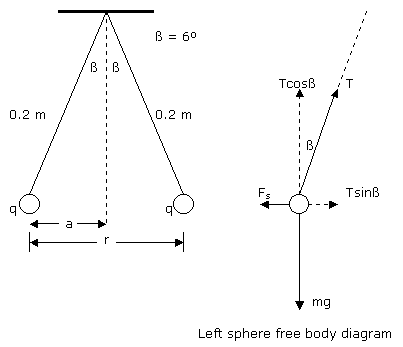Coulomb's Law Explained, Press Here
Solved Physics Homework Examples, Problems on Coulomb's Law.
Our physics homework helper will email you your physics homework as shown with the solved examples shown below. Our helper also attends by fax upon request.
Exercise One, Homework Help Solutions. Coulomb's Law Applied to a Case of Electrical Interaction Between Equal Sign Charges.
Two small similar spheres with the same negative charge and 40 g of mass each are hanging at rest as indicated in the figure. The length of each string is 20 cm and the angle ß is 6º. Calculate how many electrons are needed to add to each sphere to obtain this situation.

The spheres distance is 2a and a is obtained from sin6º = a/0.2m, this is a = 0.021 m. The distance r between the spheres is then 0.042 m.
On the left sphere's free body diagram, where T is the string tension, Fs is the repulsed force the right sphere exerts over the left one and mg is the sphere weight. Then we have:
1)
Sum of Fx = Tsinß - Fs = 0
2) Sum of Fy = Tcosß
- mg = 0 or T = mg/cosß, which replaced in ![]() 1)
we get: Fs = (mg/cosß)sinß = mgtgß = (40x10-3 kg)(9.8
1)
we get: Fs = (mg/cosß)sinß = mgtgß = (40x10-3 kg)(9.8
![]() m/s2)tan6º
= 4.12x10-2 N.
m/s2)tan6º
= 4.12x10-2 N.
The charge q on each sphere is calculated using Coulomb's law,
![]() Fs
= ke q2 /r2.
Fs
= ke q2 /r2.
Replacing r for 0.042 m and Fs for 4.12x10-2 N and solving for q2, q2 = Fs r2/ke = (4.12x10-2 N)( 0.042 m)2/9x109 Nm2/C2. Then q = 8.98x10-8 C.
The number of electrons needed to add to each sphere is 8.98x10-8 C/1.602x10-19C = 5.6x1011 electrons.
Exercise Two, Homework Help Solutions. Coulomb's Law Applied to a Case of Three Point Charges
Assume three point charges located at the vertex of a right triangle as shown in the figure, where q1 = -80µC, q2 = 50µC and q3 = 70µC, distance AC = 30 cm, distance AB = 40 cm. Calculate the force over the charge q3 due to the charges q1 and q2.

The force directions coincide with the lines
joining each pair of point charges. The force that q1 exerts over
q3, F31 is of attraction. The force that q2
exerts over q3, F32 is repulsive. This is shown in the
figure where the forces F31 and F32 are vectorially
added to obtain F3. The distance between q3 and q1
is obtained from
![]() (CB)2
= (AC)2 + (AB)2 = (0.3 m)2 + (0.4 m)2
(CB)2
= (AC)2 + (AB)2 = (0.3 m)2 + (0.4 m)2
from where CB = 0.5 m
The magnitudes of such forces are:
F31 = [(9x109 Nm2
/C2)(80x10-6 C)(70x10-6 C)]/(0.5 m)2
= 201.6 N
F32 = [(9x109 Nm2/C2)(50x10-6 C)(70x10-6 C)]/ (0.3 m)2= 350 N
It is convenient to use coordinates axis as indicated, placing the origin on the charge where we need to calculate the resultant force, in this case on q3.
The resultant force is F3 = F31
+ F32 . Then in terms of components x and y:
F3x = F31x + F32x.
F3y = F31y + F32y.
F31x = F31cosß = (201.6
N)(0.4/0.5) = 161.3 N ; F31y = - F31senß =-(201.6 N)(0.3/0.5)
= -121 N
F32 = 0 ; F32y
= F32 = 350 N.
F3x= 161.3 N + 0 = 161.3 N ; F3y
= -121 N + 350 N = 229 N.
The magnitude of the resultant force F3
is obtained from (F3)2 = (F3x)2
+ (F3y)2, giving F3 = 280 N. The angle this
force makes with the x axis is calculated using tgµ = F3y/ F3x=
229/161.3 = 1.42, then µ = arctan1.42 = 54.8º.
Note: You can access detailed information about our physics homework help by clicking below on "Physics, Detailed Homework Scope".
Related Sites:
· Physics, Main Page
· Physics, Mathematics
· Physics, Detailed Homework Scope Help
· Energy, Work and Power: Concepts
· Kinetic Energy
· Potential Energy
· Power
· Physics Problems, Example
· Physics Homework - Mechanical Energy Conservation Problems
· Physics Homework - Mechanical Power Problems
· Electric Field Charges
· Electric Field Exercises
· Electric Potential Energy
· Exercises, Electric Potential Energy
· Ohm's Law, Principle
· Ohm's Law Exercises
· Gauss' Law
· Gauss' Law Exercises
· Second Newton's Law
· Second Newton's Law Examples, Part One
· Second Newton's Law Examples, Part Two
· Sound Waves
· Sound Waves: Standing, Interference, Doppler Effect - Examples
· Sound Waves, Doppler Effect - Examples
· Vectors, Scalars
· Vectors, Scalars - Analytic Method
· Addition Vector Tools, Problems
· Free Fall Theory
· Free Fall Exercises, Part One
· Free Fall Exercises, Part Two
· Free Fall Exercises, Part Three